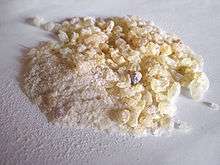Dammar gum
Dammar, also called dammar gum, or damar gum, is a resin obtained from the tree family Dipterocarpaceae in India and East Asia, principally those of the genera Shorea or Hopea (synonym Balanocarpus). Most is produced by tapping trees, however, some is collected in fossilised form on the ground. The gum varies in colour from clear to pale yellow, while the fossilised form is grey-brown. Dammar gum is a triterpenoid resin, containing many triterpenes and their oxidation products. Many of them are low molecular weight compounds (dammarane, dammarenolic acid, oleanane, oleanonic acid, etc.), but dammar also contains a polymeric fraction, composed of polycadinene.[1]

Uses
Dammar is used in foods, as a clouding or glazing agent, and in incense, varnish and other products. Dammar varnish, made from dammar gum dissolve in turpentine, was introduced as a picture varnish in 1826;[2] commonly used in oil painting, both during the painting process and after the painting is finished.[3]
Dammar crystals are also dissolved in molten paraffin wax to make batik, to prevent the wax from cracking when it is drawn onto silk or rayon.
Damar crystals are dissolved into beeswax with pigment added to harden it in order to make encaustic paints.[4]
Dammar resins were often used in the past to caulk ships, frequently together with pitch or bitumen.[5]
Damar gum is a common mounting material along with canada balsam for preparing biological samples for light microscopy.[6]
The name dammar is a Malay word meaning ‘resin’ or ‘torch made from resin’.
There are two further types of dammar, besides the gum:
- Mata kucing (‘cat's eye’) is a crystalline resin, usually in the form of round balls.
- Batu (‘stone’) is stone or pebble-shaped, opaque dammar collected from the ground.
Material safety
Physical data
- Appearance: white powder
- Melting point: approx. 120 °C
- Density: 1.04 to 1.12 g/ml
- Refractive index: approx. 1.5
- CAS number: 9000-16-2
- EINECS: 232-528-4
- Harmonised Tariff: 1301-90
Stability and toxicity
The gum is stable, probably combustible and incompatible with strong oxidising agents. Its toxicity is low, but inhalation of dust may cause allergies.
See also
- Agathis (Araucariaceae), synonym Dammara
- Canarium strictum (Burseraceae), source of black dammar
- Kauri gum, from Agathis australis
- Shorea hypochra (Dipterocarpaceae), source of dammar temak
- Shorea robusta (Dipterocarpaceae), source of sal dammar
- Vateria indica (Dipterocarpaceae), source of white dammar
References
- Scalarone, D.; Duursma, M.C.; Boon, J.J.; Chiantoire, O. MALDI-TOF mass spectrometry on cellulosic surfaces of fresh and photo-aged di- and triterpenoid varnish resins. J. Mass. Spec. 2005, 40, 1527-1535. doi:10.1002/jms.893
- William Theodore Brannt (1893). Varnishes, lacquers, printing inks and sealing-waxes: their raw materials and their manufacture. H.C. Baird & Co. p. 168.
- Mayer, Ralph (1991). The Artist's Handbook of Materials and Techniques (5th ed.). Viking Adult. ISBN 0-670-83701-6.
- 1895-1979., Mayer, Ralph (1991). The artist's handbook of materials and techniques. Sheehan, Steven. (Fifth edition, revised and updated ed.). New York. ISBN 0670837016. OCLC 22178945.CS1 maint: numeric names: authors list (link)
- Burger, P.; Charrié-Duhaut, A.; Connan, J.; Flecker, M.J.; Albrecht, P. Archaeological resinous samples from Asian wrecks: Taxonomic characterization by GC–MS. Analytica Chimica Acta. 2009, 648, 85-97. doi:10.1016/j.aca.2009.06.022
- "The microscope. Simon Henry Gage. Comstock Publishing Company, Ithaca, Philadelphia". The Anatomical Record. 5 (12): 562–562. December 1911. doi:10.1002/ar.1090051205. ISSN 0003-276X.
Further reading
- Simon, Julia (19 October 2019). "Could This Tree Be an Eco-Friendly Way to Wean Indonesian Farmers Off Palm Oil?". All Things Considered. NPR. Retrieved 20 October 2019.